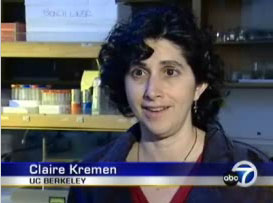
Watch Video
From KGO-TV
A tiny mite is threatening America's vast crop of fruit and vegetables. Three-quarters of all flowering plants rely on pollinators like bees in order to bear fruit. Bottom line: no bees, no produce!
They are one of nature's most masterful workers -- the honey bee. But inside these hives lurks an invader - bent on crippling the army of workers that help bring fruits and vegetables to your table.
Orin Johnson, beekeeper: "These hives that look great today could look terrible and non-rentable come February."
Second generation beekeeper Orin Johnson watches over his insect kingdom, keeping a close eye out for the varroa mite - an eight-legged predator from Europe that hides in places where honeybees lay their eggs and feeds on the developing bee larvae.
Orin Johnson, beekeeper: "They have a lot of viruses that they spin off onto bees so most of your feral bees are essentially gone."
The pest is among the causes of a bee shortage significant enough that honeybees had to be imported last year for the first time since 1922. For more than a decade, beekeepers across North America have been battling the tenacious mite. It is pretty much responsible for wiping out many honeybees in the wild. Beekeepers worry they are next as the varroa mite becomes increasingly resistant to pesticides.
Orin Johnson, beekeeper: "Most commercial beekeepers in a one-year cycle probably replace a minimum of 30 percent of their colony."
Demand for bees is expected to increase by 10 percent by 2010. A shortage of honeybees could cripple the state's $1.4 billion dollar almond industry.
Growers in California's Central Valley produce about 80 percent of the world's almonds.
In October, the National Resource Council confirmed what many researchers feared -- long-term population trends for bee populations are "demonstrably downward."
Claire Kremen, U.C. Berkeley: "You can thank a pollinator for one in every three bites of food that you eat."
Claire Kremen is an assistant professor at U.C. Berkeley's Department of Environmental Science. She worked on the National Resource Council study. She's also co-authored a new study that verifies that pollinators, like bees, affect 35 precent of the world's food production. Her research is further proof that honeybees are in trouble.
Claire Kremen, U.C. Berkeley: "We've so modified the habitat that the bees don't have their resources needs met anymore."
As a result, bees are being pushed out of farms and orchards.
Claire Kremen, U.C. Berkeley: "Change in habitat quality is the number one threat and that's because we're taking away a lot of the floral resources that support them. We used to have small farms that grew lots of different types of different crops and now we have big mono-culture farms that provide only one resource for just a couple of weeks."
While there are some pesticides to treat for mites, the pest has become immune to many of them. That is putting added pressure on commercial beekeepers like Orin Johnson, who are staying vigilant until a solution can be found. Until that time, he checks on his bees constantly and holds his breath that the varroa mite won't strike his hives.
Orin Johnson, beekeeper: "They are much more valuable than a lot of people imagine."
The U.S.D.A. says it is carefully watching the impact the varroa mite is having on honey bees. They are actually working closely with California almond growers to determine a long-term solution.
Written and produced by Ken Miguel.
